Composting with redworms is great for apartment dwellers who don’t have yard space, or for those who don’t want to hike to a backyard compost bin with their food scraps. Some kids like to keep worms for pets! By letting worms eat your food wastes, you’ll end up with one of the best soil amendments available—worm castings. This is the cheapest and easiest to manage worm bin system that I’ve seen:
Materials Needed to Make an Easy Harvester Worm Bin:
Two 8-10 gallon plastic storage boxes (dark, not see through!) as shown in pictures Cost: about $5 each
Drill (with 1/4" and 1/16" bits) for making drainage & ventilation holes
Newspaper
About one pound of redworms
Fig-1
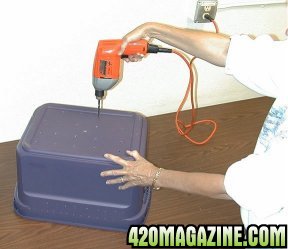
Step 1 Drill about twenty evenly spaced 1/4 inch holes in the bottom of each bin. These holes will provide drainage and allow the worms to crawl into the second bin when you are ready to harvest the castings.
Fig-2
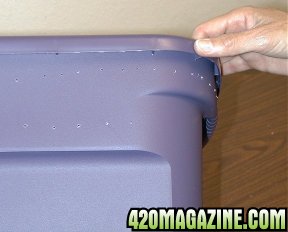
Step 2
Drill ventilation holes about 1 – 1 ½ inches apart on each side of the bin
near the top edge using the 1/16 inch bit. Also drill about 30 small holes in the top of one of the lids.
Fig-3

Fig-4
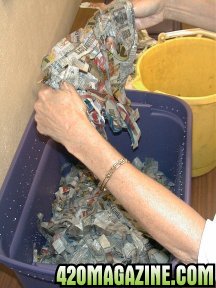
Fig-5
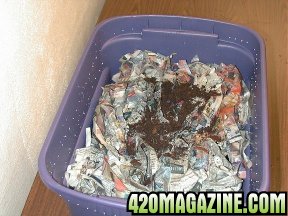
Step 3
Prepare bedding for the worms by shredding Newspaper into 1 inch strips. Worms need bedding that is moist but not soggy. Moisten the newspaper by soaking it in water and then squeezing out the excess water. Cover the bottom of the bin with 3-4 inches of moist newspaper, fluffed up. If you have any old leaves or leaf litter, that can be added also. Throw in a handful of dirt for "grit" to help the worms digest their food.
Step 4
Add your worms to the bedding. One way to gather redworms, is to put out a large piece of wet cardboard on your lawn or garden at night. The redworms live in the top 3 inches of organic material, and like to come up and feast on the wet cardboard! Lift up cardboard to gather the redworms. Or, if you wish to purchase worms, the Cooperative Extension office can give you names of suppliers in Whatcom County. An earthworm can consume about 1/2 of its weight each day. For example, if your food waste averages 1/2 lb. per day, you will need 1 lb. of worms or a 2:1 ratio. There are roughly 500 worms in one pound. If you start out with less than one pound, don't worry they multiply very quickly. Just adjust the amount that you feed them for your worm population.
Fig-6
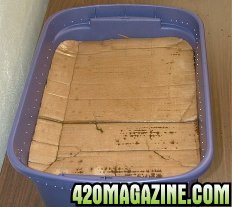
Step 5
Cut a piece of cardboard to fit over the bedding, and get it wet. Then cover the bedding with the cardboard. (Worms love cardboard, and it breaks down within months.)
Fig-7
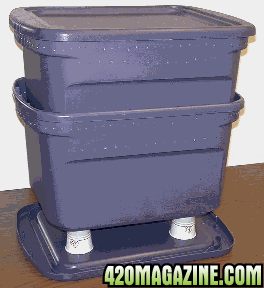
Step 6
Place your bin in a well-ventilated area such as a laundry room, garage, balcony, under the kitchen sink, or outside in the shade. Place the bin on top of blocks or bricks or upside down plastic containers to allow for drainage. You can use the lid of the second bin as a tray to catch any moisture that may drain from the bin. This "worm tea" is a great liquid fertilizer.
Step 7
Feed your worms slowly at first. As the worms multiply, you can begin to add more food. Gently bury the food in a different section of the bin each week, under the cardboard. The worms will follow the food scraps around the bin. Burying the food scraps will help to keep fruit flys away.
What do worms like to eat? Feed your worms a vegetarian diet. Most things that would normally go down the garbage disposal can go into your worm bin (see the list below). You will notice that some foods will be eaten faster than others. Worms have their preferences just like us.
Feeding your worms:
(Worms LOVE)
Breads & Grains
Cereal
Coffee grounds & filter
Fruits
Tea bags
Vegetables
(Worms HATE)
Dairy Products
Fats
Meat
Feces
Oils
When the first bin is full and there are no recognizable food scraps, place new bedding material in the second bin and place the bin directly on the compost surface of the first bin. Bury your food scraps to the bedding of the second bin. In one to two months, most of the worms will have moved to the second bin in search of food. Now the first bin will contain (almost) worm free vermicompost. (You can gently lift out any worms that might remain, and place them in the new bin, or put them into your garden!)
Materials Needed to Make an Easy Harvester Worm Bin:
Two 8-10 gallon plastic storage boxes (dark, not see through!) as shown in pictures Cost: about $5 each
Drill (with 1/4" and 1/16" bits) for making drainage & ventilation holes
Newspaper
About one pound of redworms
Fig-1

Step 1 Drill about twenty evenly spaced 1/4 inch holes in the bottom of each bin. These holes will provide drainage and allow the worms to crawl into the second bin when you are ready to harvest the castings.
Fig-2

Step 2
Drill ventilation holes about 1 – 1 ½ inches apart on each side of the bin
near the top edge using the 1/16 inch bit. Also drill about 30 small holes in the top of one of the lids.
Fig-3

Fig-4

Fig-5

Step 3
Prepare bedding for the worms by shredding Newspaper into 1 inch strips. Worms need bedding that is moist but not soggy. Moisten the newspaper by soaking it in water and then squeezing out the excess water. Cover the bottom of the bin with 3-4 inches of moist newspaper, fluffed up. If you have any old leaves or leaf litter, that can be added also. Throw in a handful of dirt for "grit" to help the worms digest their food.
Step 4
Add your worms to the bedding. One way to gather redworms, is to put out a large piece of wet cardboard on your lawn or garden at night. The redworms live in the top 3 inches of organic material, and like to come up and feast on the wet cardboard! Lift up cardboard to gather the redworms. Or, if you wish to purchase worms, the Cooperative Extension office can give you names of suppliers in Whatcom County. An earthworm can consume about 1/2 of its weight each day. For example, if your food waste averages 1/2 lb. per day, you will need 1 lb. of worms or a 2:1 ratio. There are roughly 500 worms in one pound. If you start out with less than one pound, don't worry they multiply very quickly. Just adjust the amount that you feed them for your worm population.
Fig-6

Step 5
Cut a piece of cardboard to fit over the bedding, and get it wet. Then cover the bedding with the cardboard. (Worms love cardboard, and it breaks down within months.)
Fig-7

Step 6
Place your bin in a well-ventilated area such as a laundry room, garage, balcony, under the kitchen sink, or outside in the shade. Place the bin on top of blocks or bricks or upside down plastic containers to allow for drainage. You can use the lid of the second bin as a tray to catch any moisture that may drain from the bin. This "worm tea" is a great liquid fertilizer.
Step 7
Feed your worms slowly at first. As the worms multiply, you can begin to add more food. Gently bury the food in a different section of the bin each week, under the cardboard. The worms will follow the food scraps around the bin. Burying the food scraps will help to keep fruit flys away.
What do worms like to eat? Feed your worms a vegetarian diet. Most things that would normally go down the garbage disposal can go into your worm bin (see the list below). You will notice that some foods will be eaten faster than others. Worms have their preferences just like us.
Feeding your worms:
(Worms LOVE)
Breads & Grains
Cereal
Coffee grounds & filter
Fruits
Tea bags
Vegetables
(Worms HATE)
Dairy Products
Fats
Meat
Feces
Oils
When the first bin is full and there are no recognizable food scraps, place new bedding material in the second bin and place the bin directly on the compost surface of the first bin. Bury your food scraps to the bedding of the second bin. In one to two months, most of the worms will have moved to the second bin in search of food. Now the first bin will contain (almost) worm free vermicompost. (You can gently lift out any worms that might remain, and place them in the new bin, or put them into your garden!)


